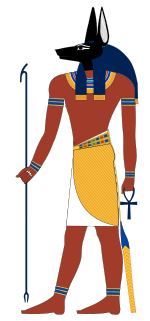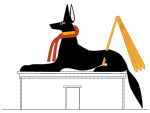Anubis
| Anubis in hieroglyphics | ||||||
|---|---|---|---|---|---|---|
| Old empire |
|
|||||
|
||||||
| New kingdom |
|
|||||
|
||||||
Anubis Jnpw The heir to the throne / Crown Prince |
||||||
| Nickname |
Neb-ta-djeser Nb-t3-ḏsr Lord of the Holy Land |
|||||
| or |
Tepi-djuef / Tepi-dju Tpj-ḏw (f) Who is on his / her mountain (overlooking the cemeteries / Holy Land) |
|||||
| or |
Imiut Jmj-wt Who is in his bandages |
|||||
| Greek | Anubis | |||||
| Coptic |
Anup ( ⲁⲛⲟⲩⲡ ) |
|||||
| Anubis with what scepter and ankh sign | ||||||
| Anubis as a canide on a shrine | ||||||
Anubis ( Egyptian Inpu ; also Anpu ) is the ancient Egyptian god of the dead rites and mummification . In connection with the Osiris myth , the origin of his name is reported: As crown prince (Inpu) who is in his bandages ( imiut ), Nephthys (for Isis ) hid him . This is how his name Anubis came about. As an epithet (nickname) Anubis is called Imiut . In this respect, Anubis is also the appearance of Horus and Osiris in equation .
presentation
Anubis is mainly represented as a lying black dog, jackal or as a person with a dog or jackal head. He usually carries a what-scepter and an ankh . Images rarely show him with a ram's head. Such a representation is, for example, in KV17 , the grave of Seti I.
cult
The jackal as a desert animal was associated with the western desert early on. In many mythologies, the west is home to both the dead and the canids (dogs, wolves, jackals), who were seen as the soul guides to the land of the dead.
Cynopolis (17th Upper Egyptian Gau ) and the necropolis Abydos and Saqqara ( Anubieion ) are given as the original cult sites for Anubis . He received his title "First of the Western" ( Chontamenti ) in Abydos. He is closely related to the Upper Egyptian god Upuaut .
Since the New Kingdom, Anubis supervised the correct care of the corpse and its embalming (mummification). In the grave he received the mummy , performed the ceremony of the mouth and led the soul to the "Field of Celestial Offerings" where he put his hand protectively on the mummy. Anubis has been the judge of the dead since the Old Kingdom , and together with Thoth he leads the judgment of the hereafter . His primary role was overseeing the soul-balancing , and his judgment was vital. That is why the prayers for the dead were addressed to him too. Death priests wore his mask ( example ) while they officiated. He was responsible for accompanying the deceased during their journey eastwards into the Duat to the banks of the Eridanus ( Eridanus (constellation) ). In Egyptian mythology, the Eridanus is the border between the realm of the living and the world beyond. During the crossing of the Eridanus the deceased were supported by the "heavenly ferryman" Mahaf who is possibly a form of the moon god Thoth.
Later, when Osiris replaced Anubis as the deity of the dead , Anubis was seen as his subordinate and now led the weighing of the heart at the judgment of the dead. Those who did not pass this test were then devoured by Ammit .
Anubis was the patron god of the Egyptian military . From the time of the New Kingdom exist tomb seals that depict Anubis sitting on the nine arches , which is supposed to symbolize his dominance over the enemies of Egypt.
mythology
In mythology, Anubis is said to be one of the four children of the god Re . According to a later version of the Osiris myth , he is the son of Osiris and his sister Nephthys . Since the Old Kingdom, Hesat has been his mother and Qebehut his daughter.
After Osiris had been dismembered by his brother Seth and distributed all over the world, Anubis and Isis collected all body parts again. Afterwards he is said to have succeeded in putting Osiris back together by mummifying him . This is how Anubis, according to the myth , carried out the first mummification on a corpse. For Osiris he then performed the funeral rites that became the model for all burial ceremonies.
The constellation of Anubis roughly corresponds to today's constellation Rabbit .
Significance among the Greeks
In Greek mythology, Anubis is equated with the soul guide Hermes . Analogous to Hermes, Anubis accompanies the deceased to the bank of the afterlife river Eridanus. The equivalent of the ferryman Charon , who translated the deceased with his ferry across the Styx to Hades , is in Egyptian mythology the "heavenly ferryman" Mahaf and / or the moon god Thoth .
See also
literature
- Hans Bonnet : Real Lexicon of Egyptian Religious History. (RÄRG). 3. Edition. de Gruyter, Berlin / New York 2000, ISBN 3-11-016884-7 .
- Veronica Ions: Egyptian Mythology. Vollmer, Wiesbaden 1968; Original title: Egyptian mythology. 1st edition. Hamlyn, London 1968.
- Hermann Kees : The belief in gods in ancient Egypt. 4th edition. Akademie-Verlag, Darmstadt 1980.
- B. Altenmüller. In: Wolfgang Helck , E. Otto (Ed.): Lexicon of Egyptology. Volume 1. Wiesbaden 1975, pp. 327-333.
Web links
- Holger Kockelmann: Anubis. In: Michaela Bauks, Klaus Koenen, Stefan Alkier (eds.): The scientific biblical lexicon on the Internet (WiBiLex), Stuttgart 2006 ff., Accessed on May 26, 2012.
- Anubis
Individual evidence
- ^ Wolfgang Wegner: Anubis. In: Werner E. Gerabek , Bernhard D. Haage, Gundolf Keil , Wolfgang Wegner (eds.): Enzyklopädie Medizingeschichte. De Gruyter, Berlin / New York 2005, ISBN 3-11-015714-4 , p. 74.
- ^ Richard H. Wilkinson : The complete gods and goddesses of ancient Egypt. Thames & Hudson, London / New York 2003, ISBN 0-500-05120-8 , pp. 188-190. (German title: The World of the Gods in Ancient Egypt - Faith, Power, Mythology - translated by Thomas Bertram. Theiss, Stuttgart 2003, ISBN 3-8062-1819-6 .)


